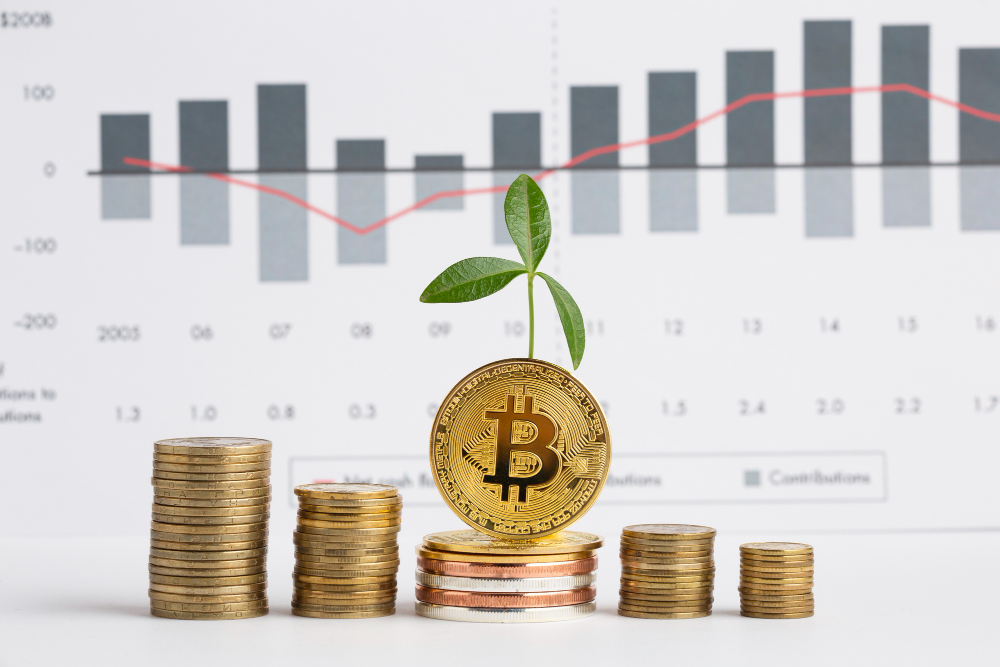Inflationary and deflationary cryptocurrencies are opposite sides of the same coin. The first one consists of increasing cryptocurrencies in circulation, while deflationary cryptocurrencies have a limited amount circulating (this amount usually remains the same, it doesn’t increase). Or, if they eventually do, it rises at a slower pace.
What is a Deflationary Cryptocurrency?
A deflationary cryptocurrency is a cryptocurrency that reduces supply over time, resulting in a limited amount of the currency in circulation and ultimately increasing its value. This reduction of supply happens in two ways. One is through buyback-and-burn, in which developers repurchase a large number of cryptocurrencies and send them to a dead wallet (or in crypto slang, “burns” them) so that it’s no longer in circulation.
The second way is through transaction fees–also called burn-on transactions. The coin’s contract states that the tax applied to all on-chain transactions that involve that coin will be burned and removed from circulation.
However, to better understand deflationary cryptocurrencies, you should first understand more about the concept of inflation and deflation.
Inflation vs Deflation: What Are the Differences?

If you Google “inflation and deflation,” you will find that inflation increases the price of goods and services and that deflation is the opposite phenomenon, where prices for goods and services go down.
But why do these phenomena occur? After all, prices can go up or down for various reasons, being the laws of supply and demand one of them.
Well, when there is an increasing amount of money in circulation, the value of this currency drops. As part of the logic of the market economy, everything abundant and easier to access tends to devalue over time. As a result, consumers will need more units of the same currency to trade for a specific good or service. This phenomenon is called inflation.
When the supply of money and credit drops, the price of goods and services declines, and the amount of money in circulation remains the same, it is called deflation.
With global inflation on the rise–mostly associated with the Covid-19 pandemic–deflationary cryptocurrencies are now in the spotlight as a way to dodge inflation.
What is an Inflationary Cryptocurrency?
In an inflationary system, the total amount of money circulating in the economy increases continuously. Thus, the value reflected in currency declines, and capital loses value. In crypto, the same phenomenon occurs–as cryptos are simply a digital currency. An inflationary cryptocurrency is when the number of tokens in circulation rises.
One example of an inflationary cryptocurrency is Dogecoin. In 2014, one of its creators abolished a hard cap of 100 billion to ensure the cryptocurrency had an unlimited supply. Over time, its value has gone through severe fluctuations. If you go back to May 7, 2021, you might recall that the altcoin with the iconic Shiba Inu dog logo spiked, reaching its all-time high of $0.64. A few days later, the token was worth $0.30. Today, the current price is near $0.10.
Moving away from the meme altcoin, here is another–quite surprising–example of a token that was once purely an inflationary cryptocurrency: Ether, from the Ethereum network. However, as of August 2021, an update mandated to burn some ethers whenever the network activity rises to make the cryptocurrency deflationary.
Most Popular Deflationary & Fastest Growing Cryptocurrencies in 2023
Before we talk about the most popular deflationary cryptocurrencies, let’s explain the system around the leading crypto of all: Bitcoin.
If you are a crypto enthusiast, you already know that Bitcoin–the pioneer of all cryptocurrencies–has a hard cap of 21 million units. This number is forecast to be reached sometime in 2140.
Until then, Bitcoin uses a process called “halving,” where it cuts the number of Bitcoins that can be mined and put into circulation every four years. In 2016, the mining reward was 12.50 bitcoins. It dropped to 6.25 in 2020 and will drop to 3.125 by 2024. After 64 halvings, all 21 million Bitcoin will be in circulation. This will make Bitcoin a scarce asset, and if demand continues to rise, its value will likely spike.
So, is Bitcoin inflationary or deflationary?

Bitcoin is technically inflationary because its supply increases over time. However, the halving process automatically reduces the supply of Bitcoins by 50% every four years, which makes Bitcoin resistant to inflation – a regular process for deflationary cryptocurrencies. It means that Bitcoin, one of the fastest growing cryptocurrencies, is both inflationary and deflationary.
Besides Bitcoin, here are a few examples of the most popular deflationary cryptocurrencies in 2023.
Binance Coin (BNB)
In the beginning of the article we mentioned that some deflationary cryptocurrencies use the Buyback-and-Burn approach to reduce supply.
One of the world’s leading crypto exchanges, Binance, uses this procedure to reduce the amount of Binance Coins (BNB). Binance repurchases BNBs from investors who profited more than 20% in the previous quarter and sends them to a dead address, out of circulation. As of January 2022, the total supply of Binance Coins is a bit over 166 million.
Cronos (CRO)
Cronos (CRO) is the native token on another leading cryptocurrency platform, Crypto.com. This non-minable cryptocurrency has a limited supply of 30 billion tokens in circulation.
PancakeSwap (CAKE)
The native token of the PancakeSwap platform, CAKE, has no maximum supply – which would make it an inflationary token. However, CAKE uses a coin burn mechanism, making it deflationary.
Litecoin (LTC)
Like Bitcoin, Litecoin (LTC) also goes through a halving process every four years. However, Litecoin supply has a hard cap of 84 million units.
Solana (SOL)
Like CAKE, Solana (SOL) is both inflationary and deflationary. Having no cap on supply and distribution makes Solana an inflationary token. Also, Solana’s miners burn transaction fees, making it deflationary.
Ripple (XRP)
Ripple (XRP) is the default currency of the RippleNet platform that charges transaction fees to reduce supply. These fees don’t return to the central authority nor are used to reward validators, but are burned – thus making XRP a deflationary cryptocurrency.
Polygon (MATIC)
MATIC is a native token to the Polygon blockchain technology. Its two purposes are to pay translation fees and participate in the Proof-of-Stake (PoS) consensus program. A percentage of each block’s transaction fees is burned to provide support for the MATIC crypto’s value.
Bitcoin Cash (BCH)
Like Bitcoin, Bitcoin Cash (BCH) has a capped supply of 21 million units. And, like BTC, it also uses a halving process that reduces the mining rate by 50% every four years. In addition, Bitcoin Cash also burns coins: Antpool, a crypto mining pool that validates 10% of BHC transactions, burned 12% of the block reward received in 2018. As a result, the price went up.
How to Trade Crypto
You can make a crypto trade by exchanging one crypto for another (such as Bitcoin to Ethereum) or buying or selling crypto using fiat currency (like US dollar to Bitcoin). The process, however, isn’t difficult, as it just involves a few steps until you can buy or sell the cryptocurrency of your choice.
Similar to stocks and other financial markets, trading cryptocurrency can be daunting and complex, so before starting off, you should understand how blockchain technology and the market involved in trading crypto works. If you’re ready to venture into crypto trading, there are six steps to follow and we’ve detailed them in this complete guide on how to trade crypto..
Pros & Cons of Cryptocurrency
Cryptocurrencies are highly volatile, so it’s very common to see Bitcoin prices fluctuate over 10% in a single day. This is a great opportunity for high-risk profiles to make a profit quicker with crypto trading.
But is crypto worth investing? Or is it something for you? If you can handle volatility and are okay with the risk of loss (in case you can’t access your crypto wallet or private key) and security, cryptocurrencies have high return potential (oftentimes higher than the stock market), it gives users anonymity, and it’s very accessible and versatile–it only takes a few minutes to trade and transfer Bitcoin or any other crypto.
Frequently Asked Questions (FAQs) for Deflationary Cryptocurrencies
We’ve wrapped up some of the most frequently asked questions about inflationary and deflationary cryptocurrencies.
Bottom Line on Deflationary Cryptocurrencies
In short, deflationary cryptocurrencies are digital assets with limited or decreasing supply over time. In other words, the number of units – or tokens – doesn’t increase at all, or if it does, increases very slowly. As a result, the value of each coin rises as long as the demand remains consistent.
Deflationary cryptocurrencies are often classified as assets that protect money from inflation. With a limited supply and high demand, its tokens increase value–as opposed to inflationary currencies, in which its increasing supply lowers purchase power.

